|
|
|
|
|
|
|
|
|
|
|
|
|
 |
 |
 |
 |
|
 |
 |
 |
 |
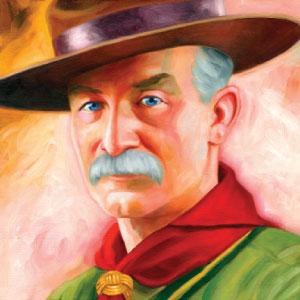
|
Robert Stephenson Smyth Baden-Powell (1857-1941)
In
October 1899, several thousand Boer fighters laid siege to the South
African town of Mafeking, where Col. Robert Baden-Powell led a force of
some 800 British soldiers. Through sheer resourcefulness, he held off
the Boers for 217 days, sneaking reports through the lines that ended
up on the front pages of British newspapers. When Mafeking was relieved
in May 1900, he became a national hero.
Three years later, Baden-Powell (by then a general) returned to
England and was astonished to find British boys using an army manual
he’d written called Aids to Scouting as a guide to outdoor fun. For the next four years, he studied boys’ programs—including Ernest Thompson Seton’s Woodcraft Indians in America—and decided to start his own program.
In 1906, Baden-Powell drafted a paper called “Boy Scouts—A
Suggestion,” proposing a way to “help in making the rising generation,
of whatever class or creed, into good citizens at home or for the
colonies.” A year later, he organized a camp on Brownsea Island to test
his ideas. The camp, which involved 12 upper-class boys and nine
working-class boys, was a rousing success.
In 1908, Baden-Powell published Scouting for Boys and
formally launched the Boy Scout movement. Over the next few years, he
watched as Scouting spread throughout the British colonies and beyond.
In 1913, he proposed a gathering of Scouts from around the world,
planting the seeds for what would become the first World Scout Jamboree
in 1920 in London, England. When he rose to speak at the jamboree, a
Scout in the audience shouted, “Long live the Chief Scout of the
World!” Thousands of other Scouts took up the call, and Baden-Powell
was officially crowned the first—and only—Chief Scout of the World.
For more on B-P:
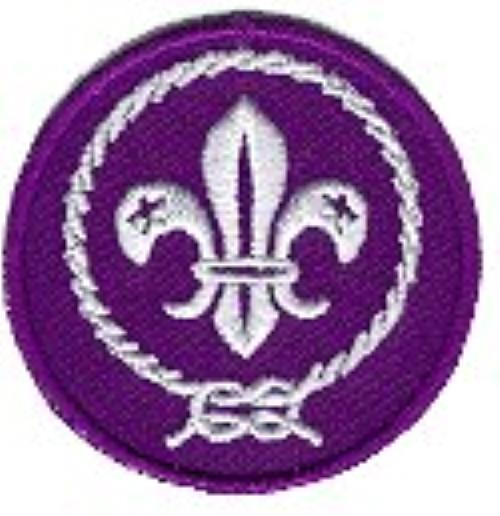 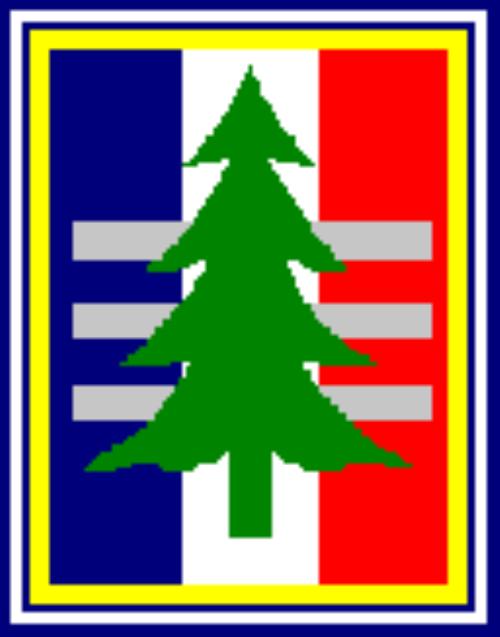 
Back to top
Section last updated/reviewed 07 Sept 12.
Please note that the images and logos here, as on all our pages, are
© (copyright) their respective owners and used by gracious permission. See
our Special Thanks! page for details and links.
|
|
 |
 |
|
 |
 |
 |
 |
 |
 |
 |
 |
|
 |
 |
 |
 |
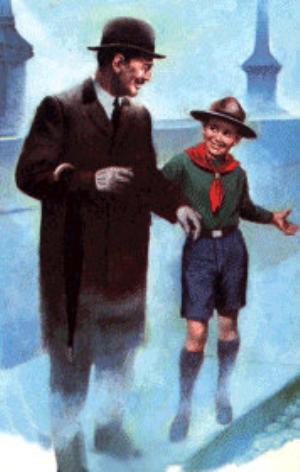
|
The Story:
One day in 1909 in London, England, An
American Visitor, William D. Boyce, lost his way in a dense fog. He
stopped under a street lamp and tried to figure out where he was. A boy approached him and asked if he could be of help.
"You certainly can," said Boyce. He told the boy that he wanted to find a certain business office in the center of the city.
"I'll take you there," said the boy. When they got to the destination, Mr. Boyce reached into his pocket for a tip. But, the boy stopped him. "No thank you, sir. I am a Scout. I won't take anything for helping."
"A Scout? And what might that be?" asked Boyce.
The boy told the American about himself and about his brother scouts. Boyce became very interested. After finishing his errand, he had the boy take him to the British Scouting office.
At
the office, Boyce met Lord Robert Baden-Powell, the famous British
general who had founded the Scouting movement in Great Britain. Boyce was so impressed with what he learned that he decided to bring Scouting home with him.
On
February 8, 1910, Boyce and a group of outstanding leaders founded the
Boy Scouts of America.From that day forth, Scouts have celebrated
February 8 as the birthday of Scouting in the United States.
What
happened to the boy who helped Mr. Boyce find his way in the fog? No
one knows. He had neither asked for money nor given his name, but he
will never be forgotten. His Good Turn helped bring the scouting
movement to our country. In the British Scout Training Center at
Gilwell Park, England, Scouts from the United States erected a statue
of an American Buffalo in honor of this unknown scout.
One
Good Turn to one man became a Good Turn to millions of American Boys.
Such is the power of a Good Turn. Hence The Scout Slogan:
DO A GOOD TURN DAILY!
The Rest of the Story:
(from Wikipedia)
The story of the Unknown Scout has been described as "true, at least in essence."
Some details, however, have been added to the known facts. According to
Edward Rowan, Boyce stopped in London en route to a safari in British East Africa.
While an unknown Scout helped him and refused a tip, this Scout only
helped him cross a street to a hotel, did not take him to the Scout
headquarters, and Boyce never met Baden-Powell. Upon Boyce's request,
the Scout did give him the address of the Scout headquarters where
Boyce later went on his own and picked up information about the group.
Boyce returned to London after his safari and visited the Scout
headquarters again and gained the use of Scouting For Boys in the development of a U.S. Scouting program.
While Boyce's original account does not mention there being fog that
fateful day, in a 1928 account he did say there was fog. Climatologists
report no fog on that day in London.
James E. West, the first professional Chief Scout Executive of the BSA, had to contend with competing factions among the founders of the BSA, most notably Daniel Carter Beard and Ernest Thompson Seton, who pushed their pioneer heritage and American Indian themes respectively and personally ran their organizations as they
despised bureaucracy. West usually just modified the British program
and opted to push the story of Boyce and the unknown Scout. The origin
of the fog into the legend came later, but there was no fog. By 1923
the fog was firmly established as part of the legend, apparently
because in 1911 a man from Providence, Rhode Island
was lost in a fog and helped by a Scout who refused a tip. This man was
so impressed that he remembered Scouting in his will and West
recognized the value of fog to the legend.
Back to top
Section last updated/reviewed 07 Sept 12.
Please note that the images and logos here, as on all our pages, are
© (copyright) their respective owners and used by gracious permission. See our Special Thanks! page for details and links.
|
|
 |
 |
|
 |
 |
 |
 |
 |
 |
 |
 |
|
 |
 |
 |
 |
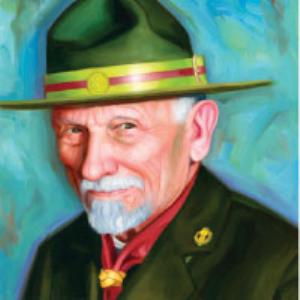
|
Daniel Carter Beard (1850-1941)
Daniel
Carter Beard grew up hearing stories of pioneer days and exploring the
woods near his Covington, Ky., home. After attending art school in New
York City, he began a long career as a writer and illustrator.
One winter day in New York, Beard came across newsboys sleeping on
the damp pavement of Printing House Square. It was this sight that
“started me on my lifelong crusade for American boyhood,” he later
wrote.
In 1905, in the pages of Recreation magazine, Beard created
a loosely organized boys’ program he called the Sons of Daniel Boone.
Somewhere between 2,000 and 20,000 boys joined the group in the next
few years, organizing themselves in “forts” and “stockades” and taking
on the names of heroes such as Daniel Boone (president), Kit Carson
(treasurer), and Davy Crockett (secretary). When Beard joined Pictorial Review magazine, he renamed the group the Boy Pioneers of America and published its first handbook.
With the advent of the BSA, Beard shut down his nascent organization
and joined the BSA as one of the first national commissioners.
“Uncle Dan,” as he was known, remained involved in Scouting until
his death in 1941—even showing up at the 1937 National Scout Jamboree
to light the opening campfire with flint and steel. He was honored with
one of the first Silver Buffalo Awards in 1926.
For more: Mertibadge.org Wikipedia
Back to top
Section last updated/reviewed 07 Sept 12.
Please note that the images and logos here, as on all our pages, are
© (copyright) their respective owners and used by gracious permission. See our Special Thanks! page for details and links.
|
|
 |
 |
|
 |
 |
 |
 |
 |
 |
 |
 |
|
 |
 |
 |
 |

|
Ernest Thompson Seton (1860-1946)
Born
in England and raised in Canada, Ernest Thompson Seton was a
naturalist, artist, and writer and lover of Native American culture.
The success of his 1898 book Wild Animals I Have Known allowed him to build a small estate in Cos Cob, Conn.
When neighborhood boys tore down part of his fence in 1902, Seton
surprised them by inviting them to camp on his property over spring
break. He declared the boys a tribe and taught skills such as
identifying birds, swimming, and canoeing. That camp evolved into the
Woodcraft Indians, an organization Seton launched that July. Over the
next eight years, between 100,000 and 200,000 boys joined the group.
In 1906, Seton sent Baden-Powell a copy of the group’s handbook, The Birch-Bark Roll of the Woodcraft Indians,
to review. Later that year, the two men met in London. Soon after the
BSA’s founding, Seton signed on as the first Chief Scout. He cobbled
together a provisional handbook from Baden-Powell’s Scouting for Boys and the Birch-Bark Roll and in the preface took credit for starting Scouting.
By 1915, Seton himself was on the outside looking in. He and Chief
Scout Executive James E. West had never seen eye to eye, and on Dec. 5,
Seton called a press conference to announce his resignation from the
BSA. His verdict on Scouting was simple: “Seton started it;
Baden-Powell boomed it; West killed it.”
In 1926, the BSA papered over its rift with Seton by giving him one of the first Silver Buffalo Awards.
For more:
ET Seton Institute Smithsonianmag.org
Infed.org Wikipedia
Back to top
Section last updated/reviewed 07 Sept 12.
Please note that the images and logos here, as on all our pages, are
© (copyright) their respective owners and used by gracious permission. See
our Special Thanks! page for details and links.
|
|
 |
 |
|
 |
 |
 |
 |
 |
 |
 |
 |
|
 |
 |
 |
 |
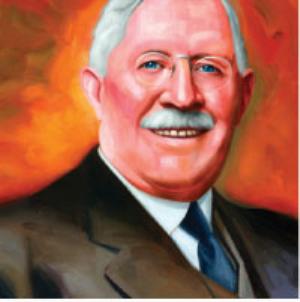
|
William Dickson Boyce (1858-1929)
Much
like Baden-Powell, Seton, and Beard, William D. Boyce, a wealthy
Chicago newspaper publisher, came to boys’ work by accident. In August
1909, he was in London, preparing for an African safari, when he got
lost in a pea-soup fog—or perhaps simply turned around (accounts
differ). In any event, a “little lad of 12” appeared and guided him
safely across the street. When Boyce offered a tip, the boy declined,
explaining that he was just doing his Good Turn as a Scout.
Boyce, who employed as many as 20,000 newsboys back home, was so
impressed by the Scout that he decided to investigate further. He
picked up a trunk full of publications at Scout headquarters and
studied them during his safari. Six months later, on Feb. 8, 1910, he
incorporated the Boy Scouts of America.
Despite his interest in youth and in Scouting, Boyce had neither the
time nor the inclination to run the BSA. He quickly turned its
leadership over to Edgar M. Robinson, the senior boys’ work secretary
of the YMCA’s International Committee in New York. Boyce did agree to
give the BSA $1,000 per month for operating expenses—provided that boys
of all races and creeds be included—but that was the extent of his
involvement.
In 1915, he founded a new Scouting organization, the Lone Scouts of
America, to serve boys that BSA troops couldn’t reach. The LSA competed
with the BSA’s Pioneer Division (created in 1916) for nearly a decade,
until Boyce agreed in 1924 to merge it with the BSA.
Boyce received the third Silver Buffalo Award in 1926. (The first
two had gone to Robert Baden-Powell and the Unknown Scout.) At his
funeral three years later, 32 Scouts served as honorary pallbearers,
while Chief Scout Executive James E. West provided the eulogy.
For more:
Wikipedia The Extra Mile
Absolute Astronomy Illinois Review
Back to top
Section last updated/reviewed 07 Sept 12.
Please note that the images and logos here, as on all our pages, are
© (copyright) their respective owners and used by gracious permission. See
our Special Thanks! page for details and links.
|
|
 |
 |
|
 |
 |
 |
 |
 |
 |
 |
 |
|
 |
 |
 |
 |
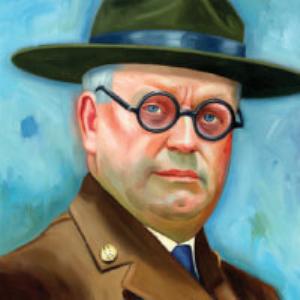
|
James Edward West (1876-1948)
Orphaned at age six and afflicted with tuberculosis, James E. West never had much of a childhood.
West had to fight for permission to attend school outside of his
orphanage—and only if he did his extensive orphanage chores before and
after school.
Nonetheless, he finished high school in two years, graduating with
honors in 1895. By 1901, he’d worked his way through law school and was
practicing law in Washington, D.C.
Given those circumstances, it was not surprising, then, that West
gravitated toward children’s issues. When a young boy stole his car, he
declined to press charges, offering instead to represent the boy in
court (he got him off on a technicality). That incident led West to
lobby successfully for the creation of a juvenile court. He also worked
for the Washington Playground Association and the YMCA and prompted
President Theodore Roosevelt to convene a White House Conference on
Dependent Children in 1909.
Given his background, West became a natural choice to serve as the
first Chief Scout Executive. He agreed to take the job for up to six
months and stayed on for 32 years.
Unlike Baden-Powell, Beard, and Seton, West had neither a winning
personality nor a love for the outdoors. Unlike Boyce, he didn’t have
deep pockets. What he did have, though, was a commitment to children
and a drive to turn the fledgling BSA into a strong, cohesive national
organization.
In his three decades as Chief Scout Executive, West oversaw the
creation of Sea Scouting and Cub Scouting, the development of local
councils, and the involvement of Scouts on the home front in two world
wars. As President Harry Truman wrote in a telegram to West’s widow,
“Boy Scouts of all ages and all Americans who believe in the future of
the American boy bow in reverence to his memory.”
West’s name lives on in the James E. West Fellowship Award. This
award goes to individuals who donate $1,000 or more to a local
council’s endowment fund.
For more: Wikipedia Absolute Astronomy
Back to top
Section last updated/reviewed 07 Sept 12.
Please note that the images and logos here, as on all our pages, are
© (copyright) their respective owners and used by gracious permission. See
our Special Thanks! page for details and links.
|
|
 |
 |
|
 |
 |
 |
 |
 |
 |
 |
 |
|
 |
 |
 |
 |
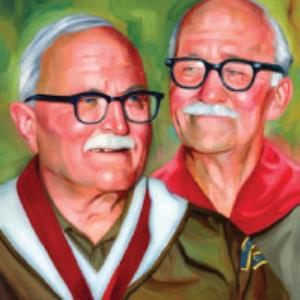
|
E. Urner Goodman (1891-1980), Carroll A. Edson (1891-1986)
The
founders of the Order of the Arrow—Scouting’s brotherhood of cheerful
service—weren’t brothers. Maybe they could have been. In many ways, E.
Urner Goodman and Carroll A. Edson led parallel lives. Both were born
in 1891, both worked as Scouting volunteers and professionals, both
were active church leaders, both served in World War I, and both lost
sons in World War II.
Most significantly, both were tapped to lead Treasure Island Scout
Reservation near Philadelphia in 1915. Goodman, the director, had read
about a camp honor society that helped maintain camp traditions from
season to season. Edson, the assistant director, had heard BSA founder
Ernest Thompson Seton talk about the Native American traditions
underlying his Woodcraft Indians. The young leaders combined those
ideas with the lore of the area’s Lenni Lenape tribe to create a
society they called Wimachtendienk Wingolauchsik Witahemui—Lenni Lenape
for brotherhood, cheerfulness, and service.
Within two years, the
society, now the Order of the Arrow, had begun spreading to other
camps. It became an official program experiment in 1922 and was
approved as part of the Scouting program in 1934.
Goodman and Edson were as responsible for the OA’s spread as they
were for its founding. Edson started OA lodges in Chicago and Jersey
City, N.J., when he served as a Scout executive in those cities.
Goodman became the first national director of program in 1931, a job
where he oversaw the growth of Cub Scouting, Exploring, and the OA.
Both men retained their ties to Scouting until their deaths. As
Goodman said late in life, “That’s the happy thing about finding the
right life mission. It doesn’t end with professional retirement. It
goes on and on until one day the call comes to enter the life beyond
where, I am sure, new and greater missions await.”
For more: Wikipedia
Back to top
Section last updated/reviewed 07 Sept 12.
Please note that the images and logos here, as on all our pages, are
© (copyright) their respective owners and used by gracious permission. See
our Special Thanks! page for details and links.
|
|
 |
 |
|
 |
 |
 |
 |
 |
 |
 |
 |
|
 |
 |
 |
 |
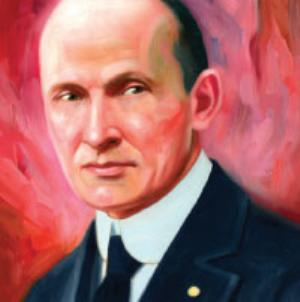
|
Edgar M. Robinson* (1867-1951)
Edgar M. Robinson led the BSA for just eight months, but they were critical months for the movement.
In early 1910, Robinson was serving as senior secretary of the
YMCA’s Committee on Boys’ Work. He’d heard of Baden-Powell’s Boy Scouts
and knew that many local Y’s were adopting it. When he learned that
Boyce had incorporated the BSA, he offered his assistance.
Boyce handed the reins to Robinson after the May 1910 national
meeting in Chicago. The next month, Robinson opened the BSA’s first
national office, a single room next to his office at YMCA headquarters,
and formed an organizing committee that included his friend Ernest
Thompson Seton and several YMCA colleagues.
Robinson convinced Seton, Beard, and leaders of other organizations
to merge with the BSA and recruited an impressive group of men to the
National Council, including Admiral George Dewey and former President
Theodore Roosevelt. He also oversaw planning for the first BSA handbook
and the first BSA camp program.
But Robinson’s true love was the YMCA, so he turned down the
invitation to serve as the BSA’s first Chief Scout Executive. Instead,
he helped recruit West, who began work on Jan. 2, 1911. Robinson then
returned to the Y, where he remained until his retirement in 1927. He
received one of the BSA’s first Silver Beaver Awards in 1926 and was
inducted into the YMCA Hall of Fame in 2000.
*Not to be confused with Edgar G. Robinson, a well known actor of the early to mid 20th Century.
Back to top
Section last updated/reviewed 07 Sept 12.
Please note that the images and logos here, as on all our pages, are
© (copyright) their respective owners and used by gracious permission. See
our Special Thanks! page for details and links.
|
|
 |
 |
|
 |
 |
 |
 |
 |
 |
 |
 |
|
 |
 |
 |
 |
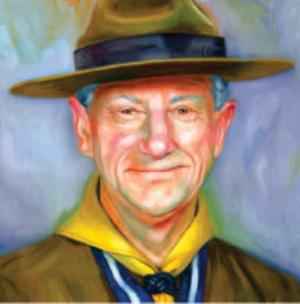
|
William Hillcourt (1900-1992)
Known to generations of Scouts as “Green Bar Bill,” William Hillcourt wrote three editions of The Boy Scout Handbook, three patrol leader handbooks, the first American Scoutmaster’s handbook, the first Scout Fieldbook, numerous other books, and a Boys’ Life column that ran from 1932 to 1965.
Born in Denmark as Vilhelm Hans Bjerregaard Jensen, Hillcourt earned
Danish Scouting’s highest rank, Knight-Scout, in 1918 and attended
World Scout Jamborees in 1920 and 1924. At the 1924 event, he met
American Scouter William Wessel, who helped him get a job with the BSA
in the United States in 1926.
A chance encounter with Chief Scout Executive James E. West later
that year launched Hillcourt’s career. After West asked the young Dane
what he thought of American Scouting, Hillcourt sent him an 18-page
report and, within a week, West assigned Hillcourt to write the first Handbook for Patrol Leaders,
which appeared in 1927. Hillcourt established himself as the BSA’s
leading proponent of the patrol method; his nickname stemmed from the
two green bars on the patrol leader patch.
In 1934, Hillcourt moved to the Schiff Scout Reservation in New
Jersey, where he founded a troop to test his ideas. He continued to
serve as Troop 1’s Scoutmaster for 15 years.
Hillcourt retired from the BSA in 1965, but he returned in 1978 to write the ninth edition of the Boy Scout Handbook. He received the Silver Buffalo Award in 1980.
For more: Wikipedia Scouter.com
Back to top
Section last updated/reviewed 07 Sept 12.
Please note that the images and logos here, as on all our pages, are
© (copyright) their respective owners and used by gracious permission. See
our Special Thanks! page for details and links.
|
|
 |
 |
|
 |
 |
 |
 |
|
|
|
|
|
|
|
|
|